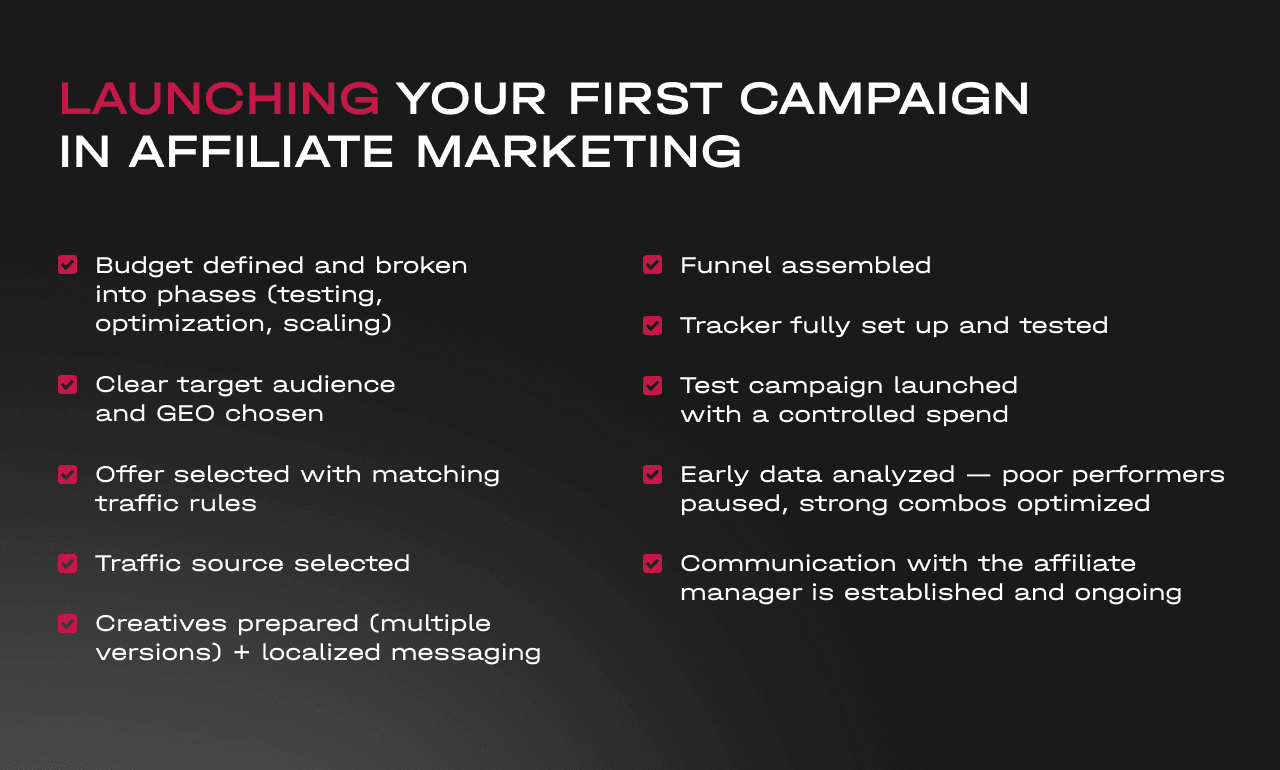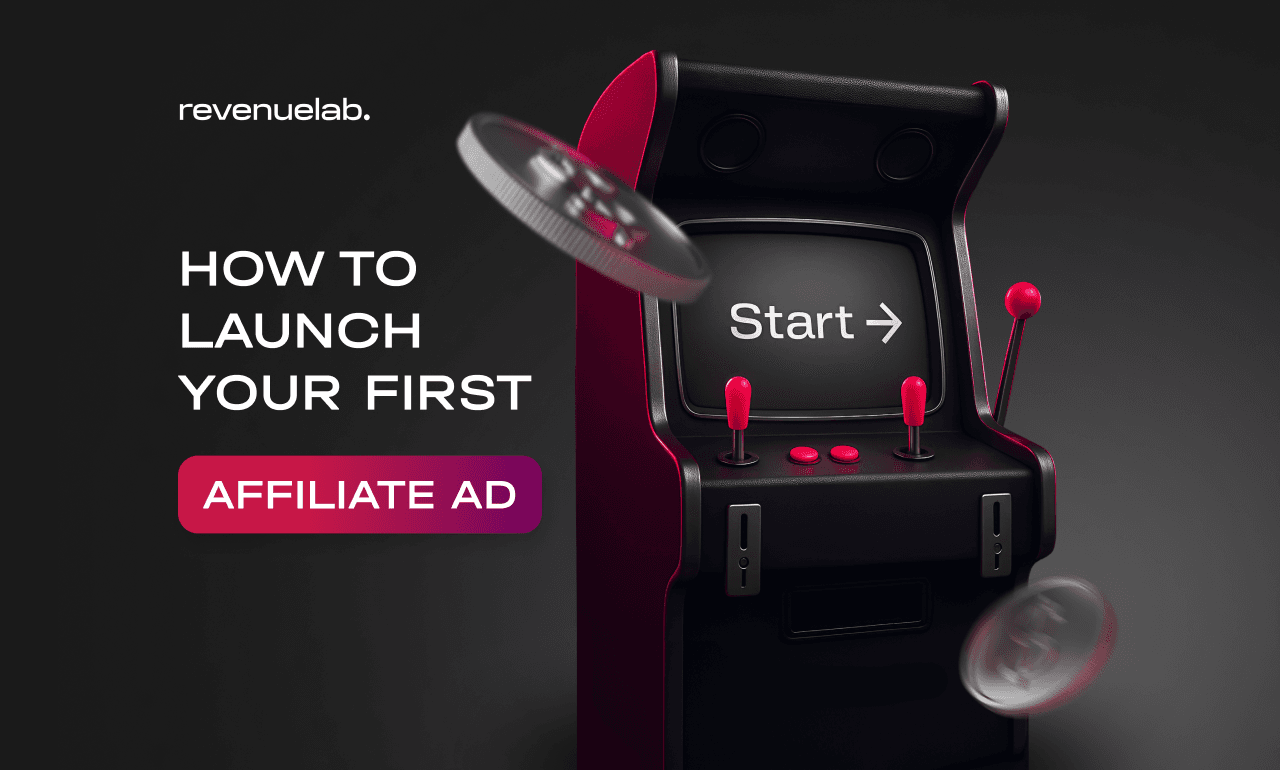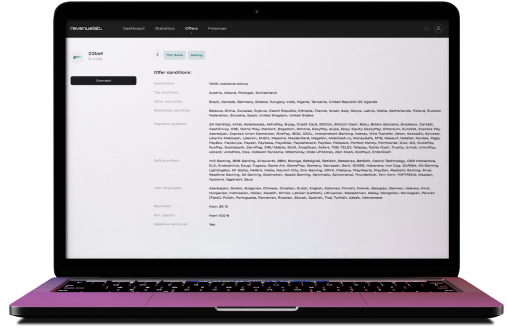Main Steps to Launch Your First Advertising Campaign as an Affiliate
1. Define Your Budget
Before choosing an offer or launching ads, you need to set a clear budget — it’s the foundation of your entire affiliate campaign management. Choose a budget that you're comfortable potentially losing while gathering data. A decent test phase might require a different volume of funds, depending on the GEO, traffic source, and payout model. If the affiliate campaign management performs well, you’ll want to scale it quickly. So, don't allocate 100% of your funds to testing — keep at least 20–30% in reserve for optimization and scaling. This helps prevent overspending too early and forces you to analyze results before increasing spend.
Without a defined budget, you risk emotional decisions, over-testing bad ideas, or pulling the plug on a campaign too soon. Set your limits before you start — and stick to them.
2. Analyze Your Target Audience (TA)
The next step is to clearly define your target audience — the people most likely to convert on your offer. In affiliate marketing, especially in iGaming, understanding your audience is essential for crafting effective creatives, choosing the right traffic source, and hitting your KPIs.
Here’s what you need to focus on:
Define the user profile
Understand behavior and motivation
Consider GEO and cultural context
Identify sites and social networks where they “live” online
Target audience analysis is foundational. Without it, you’ll waste budget on the wrong users, or worse, attract unqualified traffic that won’t convert. The better you understand your TA, the more efficient every step of your affiliate marketing campaign will be.
3. Choose an Affiliate Program and Offer
Now it’s time to pick the affiliate program and offer that best aligns with your strategy. Here’s how to make the right choice:
Decide: Affiliate Network or Direct Program?
– Affiliate networks give you access to hundreds of offers from different advertisers. Great for beginners, they usually offer faster onboarding, ready-made materials, and basic support.
– Direct affiliate programs connect you straight to the brand (casino, sportsbook, etc.). They often offer better payouts, custom deals, and more flexibility, but require trust, stability, and stronger relationships.
Evaluate the Offer Itself
Your offer is the core of your affiliate campaign management. Make sure it fits your audience, works with your traffic source, and gives you room to scale.
4. Choose Your Traffic Source
Choosing the right traffic source is critical — not all offers work equally well across all channels. The traffic source you pick should align with your audience, budget, and level of experience.
Here’s what to consider:
Match the source to the offer and GEO
Evaluate cost and learning curve
– Push traffic is cheap and fast to launch, ideal for testing.
– Facebook Ads offers advanced targeting but comes with moderation risks and a steep learning curve.
– Google Ads / PPC provides premium intent-driven traffic but is expensive and requires solid keyword research.
– SEO is great for long-term stable traffic, but takes months to show results.
– Email works well for retargeting and monetizing existing lists.
Check offer restrictions
Some offers only allow certain types of traffic. Always check the terms.
Your traffic source is the fuel for your affiliate campaign management. Choose it wisely and remember — no traffic source is perfect. What matters is how well you test, optimize, and adapt.
5. Prepare Your Ad Creatives
This is the point where your campaign either grabs attention or gets completely overlooked. In affiliate marketing, and especially in iGaming, strong creatives are what make people click, register, and deposit. Without a compelling visual and message, even the best offer won’t convert.
To make your creatives effective, you need to match them to the vertical and GEO. Use localized language, relevant imagery, and cultural references your audience will instantly recognize and trust. A slot offer in Scandinavia and a sportsbook offer in Brazil should never look or sound the same.
Never rely on a single creative. Test at least 3–5 variations, each with a different angle — for example, one focusing on a welcome bonus, another on the emotional thrill of winning. Often, the best-performing creative is not the one you expected.
For cold traffic, especially from push or social ads, consider using pre-landing pages. These pre-landers act as a warm-up, giving context, building trust, and increasing conversion rates before the user reaches the actual offer. They can be styled as quizzes, reviews, or bonus explainers, depending on your audience.
6. Build Your Funnel (a.k.a. "the Combo")
In affiliate marketing, especially in paid traffic campaigns, a combo is the full path a user takes — from seeing your ad to completing the conversion. A well-assembled combo turns traffic into revenue. A broken one burns your budget.
Here’s what a typical iGaming combo includes:
Your combo should be logical and frictionless. When everything from ad to landing works together, your CR goes up — and your ROI follows.
7. Set Up Your Tracker
It’s time to connect everything with a tracker — the brain of your affiliate marketing campaign. Without proper tracking, you’re flying blind: you won’t know which ads convert, which GEOs burn your budget, or which traffic sources are bringing in real FTDs. A tracker is one of the most important iGaming campaign management tools. It gives you the visibility and control you need to make data-driven decisions.
A good tracker breaks down performance by key metrics like CTR (click-through rate), CR (conversion rate), EPC (earnings per click), and ROI (return on investment) segmented by creative, GEO, device, OS, and even time of day. With this data, you can quickly identify winning combinations and pause underperforming ones before they drain your budget.
More importantly, a tracker removes the guesswork. Many offers don’t convert on the first click, especially in iGaming. A proper tracking setup helps you understand delayed conversions, returning users, and even detect fraudulent activity. This deeper insight allows for smarter decisions when choosing the most sustainable traffic sources.
8. Launch Your Test Campaign
Your goal at this stage is simple: collect enough data to understand what works and what doesn’t. This is the time to learn.
Start with a controlled daily budget. Launch multiple variations right from the start. Don’t test just one creative or one ad set. Try different angles, ad formats, headlines, and — if relevant — pre-landers. The goal is to identify patterns and find the strongest combinations.
Killing a campaign after 50 clicks is premature. In most iGaming verticals, a solid test requires spending at least 3–5 times the CPA payout to generate enough data. Avoid emotional decisions during this phase. Don’t shut down a variation just because it didn’t convert in the first few hours. Let the campaign run through different time zones, devices, and audience segments — especially if you’re working across global GEOs. Data needs time and volume to become meaningful.
9. Analyze and Optimize
Your goal now is to turn raw performance data into clear, actionable decisions that push your campaign from break-even to profitable. It’s no longer about guessing — it’s about making informed moves based on what the numbers are telling you.
Now focus on scaling what performs. Once you find a winning combination — for example, a specific ad + GEO + pre-lander — it’s time to push it. Raise your daily budget slowly to avoid shocking the algorithm. Duplicate the campaign with slight variations to test for even better performance. Expand into nearby GEOs or similar devices. And build new creatives based on what’s already working — the idea is to multiply your success without losing control.
Stay in touch with your affiliate manager. Share your performance data, ask for feedback, and request insight into what’s currently performing across the network. If you’re sending quality traffic, you might unlock exclusive offers or better payout terms.
Optimization is where the real money is made. Analyze the data, refine what works, scale with intention, and repeat. The affiliates who succeed long-term aren’t just creative — they’re relentless about performance and always driven by data.
Common Mistakes Beginners Make (and How to Avoid Them)
Even with a clear roadmap, affiliate marketing has plenty of traps, especially in the early stages. Here are some of the most common mistakes newbies make when launching their first campaigns, and what to do instead.
1. Running campaigns without tracking
Too many beginners try to save money by skipping a tracker and other iGaming campaign management tools. They have no idea which ads are converting or why the ROI is negative.
Fix: Always set up a tracker before launching. It’s not optional.
2. Chasing high CPA payouts
A $200 payout looks attractive — until you realize it comes with strict conversion flows and a 10% approval rate.
Fix: Choose offers with realistic flows, reliable approval, and solid EPC. High payout ≠ high profit.
3. Ignoring offer restrictions
Using the wrong traffic source can get your account banned.
Fix: Read the offer terms carefully. If anything’s unclear, ask your affiliate manager directly.
4. Launching without testing creatives
Relying on one banner or headline is a recipe for disaster.
Fix: Always test multiple creatives and angles. Let the data decide what works.
5. Scaling too early
Scaling too fast without stable data can lead to budget loss.
Fix: Wait for consistent performance across a few days. Confirm ROI stability before increasing spend.
Mistakes are part of the learning curve, but most of them are preventable with the right mindset and process. Treat your campaigns like a business. That’s how affiliates become professionals. The first affiliate marketing campaign will test your patience, your budget, and your mindset. There will be failed tests, rejected conversions, and confusing data. It’s normal. The road to profitability is rarely smooth.
A good affiliate network is a partner in your growth. When you work with a trusted team, you get access to proven offers with transparent terms, real-time tracking, and payout systems. Most importantly, you’ll be assigned a dedicated affiliate manager who can support you through every stage of your campaign. They know which offers convert, which GEOs are trending, and which traffic sources are working right now.
Don’t be afraid to ask questions or share your campaign performance. A good manager doesn’t just approve offers — they actively help you earn more. Whether you're testing creatives or trying to improve your approval rate, their input can save you time and budget.
Summing up
Launching your first affiliate marketing campaign might seem overwhelming, and that’s because it is. From choosing the right offer to tracking every click, each step demands attention, testing, and smart decision-making. But with the right structure, tools, and support, it’s absolutely doable.
Success comes from planning, learning from data, avoiding common mistakes, and building relationships with people who can guide you, like your affiliate manager. Track everything, optimize ruthlessly, and keep refining. Every failed test is one step closer to a campaign that prints profit.
Mini Checklist: First Campaign Essentials

Save this checklist. Over time, it becomes second nature — and that's when the real scaling begins.



